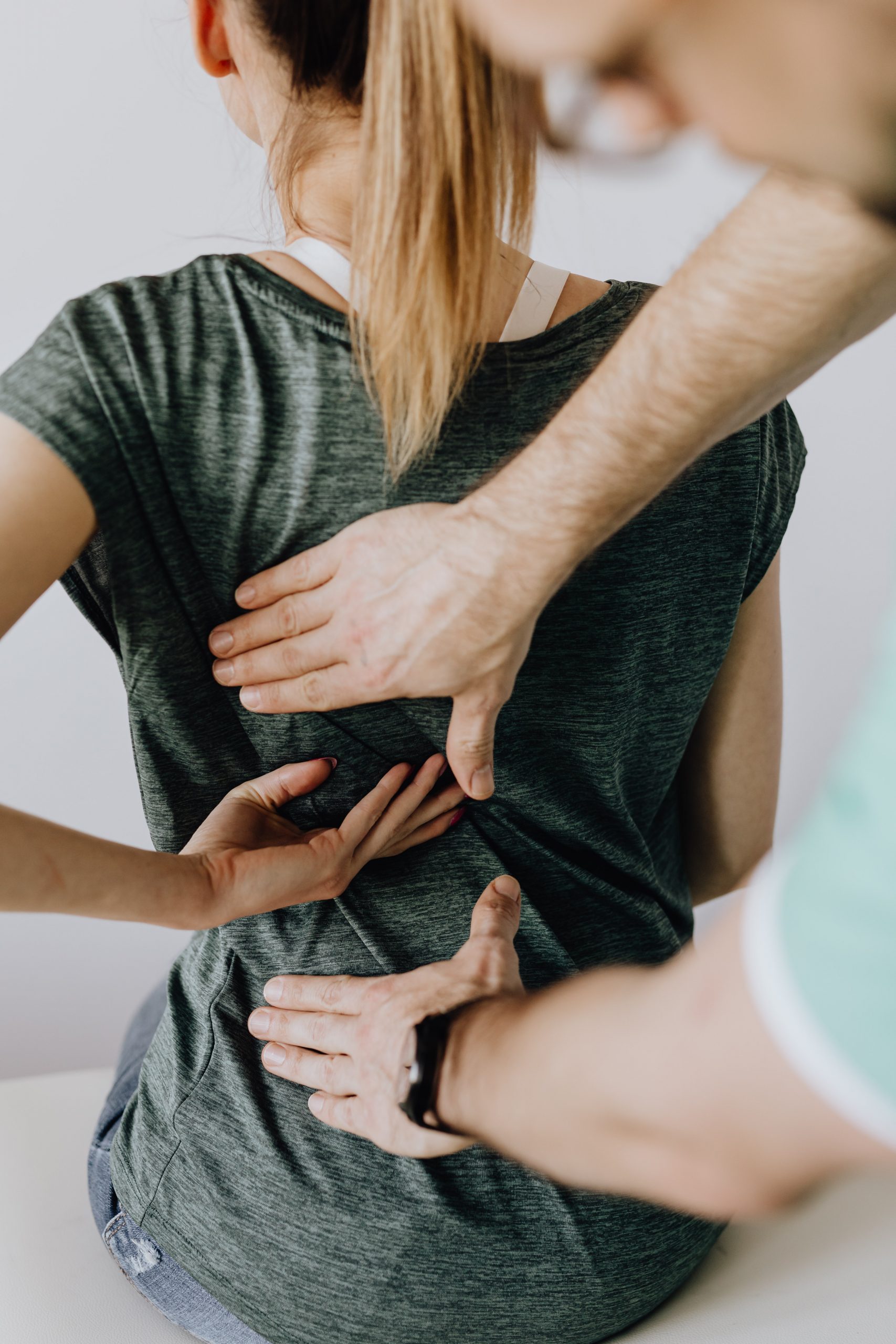For Your Safety - Screening, masks, and sanitation will continue to be implemented at our facility. Please see our blog post for more information.
Back pain is a complex topic, as it refers to a part of the body where multiple structures are working together: vertebrae, intervertebral disks, ribs, muscles, ligaments, nerves, blood vessels, organs… Each one can cause back pain if it suffers any kind of damage.
To make the topic easier, back pain is often classified by:
Time: How long has the person been experiencing the pain?
- Acute pain: From the 1st day to 4-6 weeks.
- Subacute pain: 2-3 months.
- Chronic pain: +3 months.
Localization: Where is the pain localized?
- Upper Back.
- Middle Back.
- Lower Back.
This article will cover the subject of localization, common causes and common treatment for each part of the back.
Upper Back
This area corresponds to the thoracic spine itself. It’s located below the neck (cervical spine) and above the low back (lumbar spine). It’s the most stable portion of the spine, and its mobility is limited due to the ribs.
It has:
- 12 vertebrae, attached to each rib. These vertebrae are the backside of the rib cage.
- Intervertebral disks between each vertebra, which act as shock absorbers.
- Muscles and ligaments. They move and stabilize the spine.
- The shoulder blades (called “scapulae”). These bones connect the upper limb to the trunk, and are part of each shoulder joint. Each shoulder blade has its own muscles and ligaments, therefore, any shoulder-related injury can refer pain to the upper back.
The upper back pain can be worse enough to limit activities or restrict breathing. It is usually a sharp, burning pain easily localized, or it can be an undefined area of pain, spreading to the shoulder and/or the neck.
Other symptoms present can be tightness, stiffness, headache, pain while taking a deep breath/coughing/sneezing/laughing, among others.
Common Causes
Upper back pain can be triggered by sudden movements like a whiplash. Excessive bending, carrying heavy backpacks or heavy loads, smoking, a traumatic event, or overweight/obesity can cause upper back pain as well. Other causes include:
- Excessive kyphosis: The thoracic spine has a natural curve called “kyphosis”. An excess of this curve causes a “hump” on the upper back. This causes an excess of tension in the upper back area, leading to upper back pain.
- Flat back syndrome: This is the opposite of an excessive kyphosis. Here, the thoracic spine is straightened, giving the upper back a “flat” look. It’s usually linked to lower back pain and shoulder dysfunction.
- Scoliosis: Here, the spine is twisted and bent to one side, looking like a “C” or an “S” when viewed from the back. A person can be born with scoliosis or it can be developed over time, mostly in childhood and the teenage years.
Muscle strain of:
- The muscles of the shoulder blade complex. They can radiate pain to the shoulder, the arm, and/or the upper back.
- The muscles of the thoracic spine. This can happen due to lack of strength, overuse, or bad posture (i.e. looking downward for long periods of time, like when texting, reading, or using a laptop).
Joint dysfunction of:
- The shoulder joint due to aging, sports injury, wear and tear, or a traumatic event, among others.
- The thoracic spine due to a sudden injury, or aging.
- The ribs, e.g. an intercostal neuralgia. This happens when the nerves running between each rib are compressed. This can radiate pain to the upper or middle back, depending on which nerve is affected.
Infections, osteoporosis, vertebral/rib fracture, acid reflux, cardiac conditions
Common Treatment
It will depend on the cause of upper back pain, but the most common treatments include:
Physiotherapy
- A strengthening routine for the weak muscles, to improve the posture and stabilize the shoulder and/or the trunk.
- A stretching routine for the shortened muscles.
- Heat and/or ice therapy, electrotherapy, ultrasound therapy, and/or kinesiology taping for pain management and enhance the therapy.
Massage Therapy
- Relaxes stiff muscles.
Middle Back
Even though middle back pain can be used as synonymous with upper back pain, it’s described as the pain localized above the lumbar region and below the ribcage. This area has important core muscles that could refer pain to the middle back if they’re strained or injured.
Also, most of the organs are located in that area. If the pain is severe, is not related to any traumatic event or sudden movement, and/or is accompanied by fever, sudden weight loss, dizziness, sleep disruption, lack of bladder/bowel control or other similar symptoms, don’t hesitate to go to a healthcare facility.
Common Causes
Some factors can increase the risk of developing middle back pain, such as:
- Pregnancy.
- Weight gain/loss.
- Scoliosis.
- Stress/anxiety/depression.
- Smoking.
Common Treatment
As it corresponds to the lower section of the thoracic spine, the treatment is similar to the upper back: physiotherapy and massage therapy are the most common ways for pain management.
Lower Back
This area corresponds to the lumbar section of the spine. It can include the sacral region (the base of the lumbar spine) and the buttocks.
The lumbar spine is very mobile, has to support the weight of the trunk, and has to stabilize the body. These factors make it prone to injuries.
The lower back pain can be accompanied by:
- Muscle tightness/stiffness.
- Tingling, burning, weakness or numbness sensations in one leg.
- Gait impairment.
It’s the most widely studied type of back pain due to its high incidence. It affects 60% to 80% of people throughout their lifetime, is responsible for +140 million of work-days lost in U.S. only, and costs $100 to $200 billion per year.
Common Causes
Lower back pain can be caused by many factors, such as:
- Bad posture. Also, static postures kept for long periods of time are risk factors for low back pain.
- Core weakness. The core muscles are designed to help stabilize the trunk and the spine. If they’re weak, the lumbar spine will have to support the weight alone.
- Muscle strain due to overuse, a sports injury, or a traumatic event.
- Disk herniation. Here, the intervertebral disk has a bump that can compress the spinal cord and cause severe pain, which can radiate down the leg.
- Spinal stenosis. This happens when the spinal canal is narrowed. It’s commonly caused by wear and tear”.
- Scoliosis, if the abnormal curve is located in the lumbar spine or close to it.
- Sudden moves, such as lifting, bending, pulling, or twisting with heavy loads.
- Aging. The intervertebral disk gets “dry” over time, making it prone to damage.
- Wear and tear.
- Overweight/obesity.
- Flat foot. It changes the weight distribution of the body, which could have repercussions on the lower back.
Common Treatment
As with upper and middle back pain, the common treatment includes:
Physiotherapy
It’s very effective in patients with low back pain. It can prevent the use of painkillers and facilitate the reintegration of the patient’s daily activities. It’s recommended as the first option of treatment.
Massage therapy.
It relaxes the muscles and helps to reduce pain in the short-term, among other significant benefits.
Conclusion
Back pain, whether it’s upper, middle, or lower back pain, can be prevented with physical activity and healthy habits.
If the following symptoms are present, the patient should be evaluated by a doctor as soon as possible:
- Fever.
- Unexplained/sudden weight loss.
- Pain/numbness/tingling/weakness in the arms or the legs.
- “Pins and needles” on the chest or abdomen.
- Lack of coordination.
- A severe headache.
- Severe chest pain.
- Breathing problems.
- Severe morning stiffness.
- History of a recent car accident.
- History of cancer.
- The onset of pain before the age of 20 or after the age of 50.
- Severe, constant pain that doesn’t improve by changing the position.
- Loss of bowel/bladder control.
Article Sources:
- Zhong-qiang C., Chui-guo, Sun. Clinical Guideline for Treatment of Symptomatic Thoracic Spinal Stenosis. Spine Surgery Group of Chinese Orthopedic Association. Orthopaedic Surgery. 2015 Aug; 7(3): 208–212. Available at: https://www.ncbi.nlm.nih.gov/pubmed/26311094
- Southerst, D. et al. The Effectiveness of Noninvasive Interventions for Musculoskeletal Thoracic Spine and Chest Wall Pain: A Systematic Review by the Ontario Protocol for Traffic Injury Management (OPTIMa) Collaboration. Journal of Manipulative & Physiological Therapeutics, Volume 38 , Issue 7 , 521 – 531. Available at: https://www.ncbi.nlm.nih.gov/pubmed/26141077
- Yoo, W. (2013). Effect of Thoracic Stretching, Thoracic Extension Exercise and Exercises for Cervical and Scapular Posture on Thoracic Kyphosis Angle and Upper Thoracic Pain. Journal of Physical Therapy Science, 25(11), 1509–1510. http://doi.org/10.1589/jpts.25.1509
- Benign thoracic pain. (1987). Journal of the Royal Society of Medicine, 80(10), 660. Available at: https://www.ncbi.nlm.nih.gov/pmc/articles/PMC1291064/
- Louw, A., & Schmidt, S. G. (2015). Chronic pain and the thoracic spine. The Journal of Manual & Manipulative Therapy, 23(3), 162–168. Available at: https://www.ncbi.nlm.nih.gov/pmc/articles/PMC4534852/
- Elrich, G. Low back Pain. Bulletin of the World Health Organization. 2003;81:671-676. Available at:http://www.who.int/bulletin/volumes/81/9/Ehrlich.pdf
- Delitto, A., George, S. Z., Van Dillen, L., Whitman, J. M., Sowa, G. A., Shekelle, P., … Godges, J. J. (2012). Low Back Pain: Clinical Practice Guidelines Linked to the International Classification of Functioning, Disability, and Health from the Orthopaedic Section of the American Physical Therapy Association. The Journal of Orthopaedic and Sports Physical Therapy, 42(4), A1–57. http://doi.org/10.2519/jospt.2012.42.4.A1

